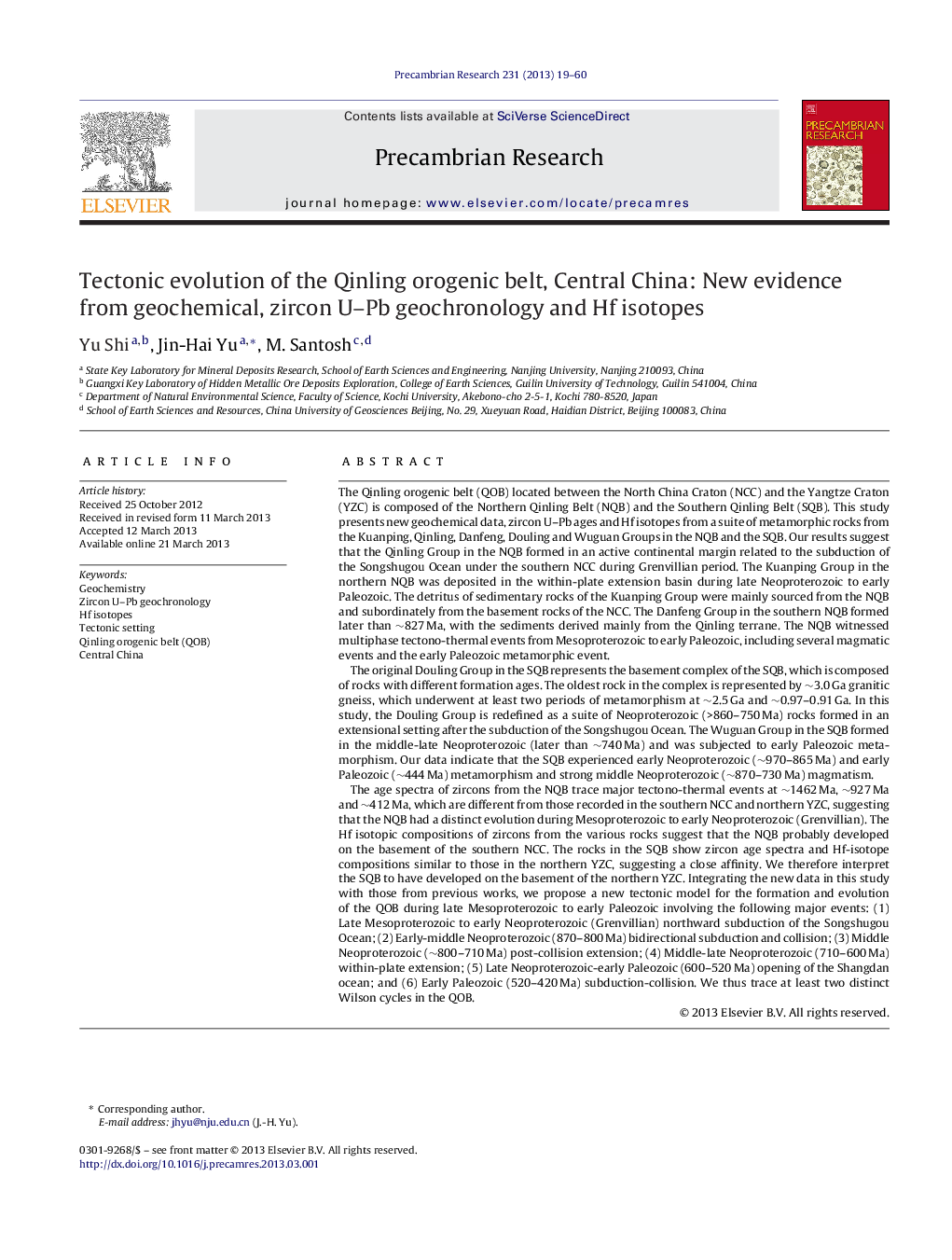| کد مقاله | کد نشریه | سال انتشار | مقاله انگلیسی | نسخه تمام متن |
|---|---|---|---|---|
| 4723207 | 1639643 | 2013 | 42 صفحه PDF | دانلود رایگان |

• New geochemical, zircon U–Pb dating and Hf isotopic data of metamorphic rocks from the Qinling orogenic belt (QOB).
• Northern Qinling Belt (NQB) experienced a distinct evolution during Grenvillian period.
• Southern Qinling Belt (SQB) developed on the basement of the northern YZC.
• A new plate tectonic model for the formation and evolution of the QOB is proposed.
The Qinling orogenic belt (QOB) located between the North China Craton (NCC) and the Yangtze Craton (YZC) is composed of the Northern Qinling Belt (NQB) and the Southern Qinling Belt (SQB). This study presents new geochemical data, zircon U–Pb ages and Hf isotopes from a suite of metamorphic rocks from the Kuanping, Qinling, Danfeng, Douling and Wuguan Groups in the NQB and the SQB. Our results suggest that the Qinling Group in the NQB formed in an active continental margin related to the subduction of the Songshugou Ocean under the southern NCC during Grenvillian period. The Kuanping Group in the northern NQB was deposited in the within-plate extension basin during late Neoproterozoic to early Paleozoic. The detritus of sedimentary rocks of the Kuanping Group were mainly sourced from the NQB and subordinately from the basement rocks of the NCC. The Danfeng Group in the southern NQB formed later than ∼827 Ma, with the sediments derived mainly from the Qinling terrane. The NQB witnessed multiphase tectono-thermal events from Mesoproterozoic to early Paleozoic, including several magmatic events and the early Paleozoic metamorphic event.The original Douling Group in the SQB represents the basement complex of the SQB, which is composed of rocks with different formation ages. The oldest rock in the complex is represented by ∼3.0 Ga granitic gneiss, which underwent at least two periods of metamorphism at ∼2.5 Ga and ∼0.97–0.91 Ga. In this study, the Douling Group is redefined as a suite of Neoproterozoic (>860–750 Ma) rocks formed in an extensional setting after the subduction of the Songshugou Ocean. The Wuguan Group in the SQB formed in the middle-late Neoproterozoic (later than ∼740 Ma) and was subjected to early Paleozoic metamorphism. Our data indicate that the SQB experienced early Neoproterozoic (∼970–865 Ma) and early Paleozoic (∼444 Ma) metamorphism and strong middle Neoproterozoic (∼870–730 Ma) magmatism.The age spectra of zircons from the NQB trace major tectono-thermal events at ∼1462 Ma, ∼927 Ma and ∼412 Ma, which are different from those recorded in the southern NCC and northern YZC, suggesting that the NQB had a distinct evolution during Mesoproterozoic to early Neoproterozoic (Grenvillian). The Hf isotopic compositions of zircons from the various rocks suggest that the NQB probably developed on the basement of the southern NCC. The rocks in the SQB show zircon age spectra and Hf-isotope compositions similar to those in the northern YZC, suggesting a close affinity. We therefore interpret the SQB to have developed on the basement of the northern YZC. Integrating the new data in this study with those from previous works, we propose a new tectonic model for the formation and evolution of the QOB during late Mesoproterozoic to early Paleozoic involving the following major events: (1) Late Mesoproterozoic to early Neoproterozoic (Grenvillian) northward subduction of the Songshugou Ocean; (2) Early-middle Neoproterozoic (870–800 Ma) bidirectional subduction and collision; (3) Middle Neoproterozoic (∼800–710 Ma) post-collision extension; (4) Middle-late Neoproterozoic (710–600 Ma) within-plate extension; (5) Late Neoproterozoic-early Paleozoic (600–520 Ma) opening of the Shangdan ocean; and (6) Early Paleozoic (520–420 Ma) subduction-collision. We thus trace at least two distinct Wilson cycles in the QOB.
Journal: Precambrian Research - Volume 231, July 2013, Pages 19–60